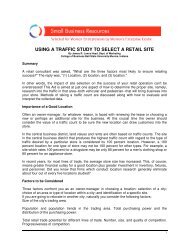Cascade NTFP Regional Profile.pdf - First Nations in British ...
Cascade NTFP Regional Profile.pdf - First Nations in British ...
Cascade NTFP Regional Profile.pdf - First Nations in British ...
You also want an ePaper? Increase the reach of your titles
YUMPU automatically turns print PDFs into web optimized ePapers that Google loves.
<strong>Cascade</strong>s <strong>NTFP</strong> <strong>Profile</strong><br />
Description of Study Area<br />
Biophysical Sett<strong>in</strong>g<br />
This mounta<strong>in</strong>ous area is one of the most biologically diverse forest districts <strong>in</strong> the<br />
Prov<strong>in</strong>ce with ecosystems rang<strong>in</strong>g from semi-arid low elevation grasslands <strong>in</strong> parts of the<br />
major valley bottoms to coastal temperate ra<strong>in</strong>forest <strong>in</strong> some western valleys found<br />
with<strong>in</strong> the Coast Range. In the western portions of the District, the valleys are typically<br />
deeply <strong>in</strong>cised with narrow low altitude valley floors and rugged mounta<strong>in</strong> tops extend<strong>in</strong>g<br />
up to 3000m. As one travels east <strong>in</strong> the District the mounta<strong>in</strong>s generally are less rugged<br />
and the valley floors more extensive and at higher elevation. With<strong>in</strong> the Lillooet TSA<br />
there are 6 biogeoclimatic zones and 46 mapped variants – this is 3 times the average of<br />
comparable sized areas <strong>in</strong> the <strong>in</strong>terior (M<strong>in</strong>istry of Susta<strong>in</strong>able Resource Management<br />
(MSRM) 2004). This results <strong>in</strong> rare mixes of plant species associated with transitional<br />
ecosystem types, such as sword fern (Polystichum munitum) grow<strong>in</strong>g underneath<br />
Ponderosa p<strong>in</strong>e (P<strong>in</strong>us ponderosa) <strong>in</strong> the Siska area. The District is primarily <strong>in</strong> the<br />
Fraser River bas<strong>in</strong> but the area near Pr<strong>in</strong>ceton is <strong>in</strong> the Columbia bas<strong>in</strong>. The spectacular<br />
Fraser Canyon provides the key ecological and logistical l<strong>in</strong>k between the coast and<br />
<strong>in</strong>terior for humans, salmon and climate. The runs of p<strong>in</strong>k, sockeye, ch<strong>in</strong>ook and coho<br />
salmon penetrate many of the major river systems <strong>in</strong> the District and have for millennia<br />
provided a crucial food source for people as well as nutrient <strong>in</strong>puts for terrestrial<br />
ecosystems.<br />
The area is under the <strong>in</strong>fluence of three major air masses: wet Pacific air, cold air from<br />
the plateau <strong>in</strong> the North and dry <strong>in</strong>terior air from the east and south (M<strong>in</strong>istry of<br />
Susta<strong>in</strong>able Resource Management (MSRM) 2004). Precipitation ranges from 300 <strong>in</strong> dry<br />
Interior valleys to 2,000 mm <strong>in</strong> the west with<strong>in</strong> the Lillooet TSA (M<strong>in</strong>istry of Susta<strong>in</strong>able<br />
Resource Management (MSRM) 2004).<br />
The follow<strong>in</strong>g protected areas are entirely with<strong>in</strong> or adjacent to the District: Mann<strong>in</strong>g<br />
Park, Cathedral Park, Ste<strong>in</strong> Valley Nlaka’pamux Heritage Park, Spruce Lake Protected<br />
Area (South Chilcot<strong>in</strong>), Duffy Lake Park, Skwaha Lake Park, Marble Canyon Park,<br />
Skihist Park and Goldpan Park.<br />
Forests with<strong>in</strong> the District conta<strong>in</strong> a diversity of native tree species that <strong>in</strong>clude:<br />
lodgepole p<strong>in</strong>e (P<strong>in</strong>us contorta), ponderosa p<strong>in</strong>e, western white p<strong>in</strong>e (P<strong>in</strong>us monticola),<br />
Douglas fir (Pseudotsuga menziesii), subalp<strong>in</strong>e fir (Abies lasiocarpa), amabilis fir (Abies<br />
amabilis), western red cedar (Thuja plicata), paper birch (Betula papyrifera), trembl<strong>in</strong>g<br />
aspen (Populus tremuloides), black cottonwood (Populus balsamifera ssp. trichocarpa)<br />
and others. With<strong>in</strong> the Merritt TSA, lodgepole p<strong>in</strong>e is the predom<strong>in</strong>ant tree species and<br />
occupies roughly 60% of the timber harvest<strong>in</strong>g landbase (Snets<strong>in</strong>ger 2005).<br />
The District currently has a number of forest health problems, <strong>in</strong>clud<strong>in</strong>g mounta<strong>in</strong> p<strong>in</strong>e<br />
beetle (MPB) (Dendroctonus ponderosa), Douglas fir beetle (D. pseudotsugae), spruce<br />
beetle (D. rufipennis), western p<strong>in</strong>e beetle (D. brevicomis), western spruce budworm<br />
(Choristoneura occidentalis), and armillaria root disease (Armillaria ostoyae). MPB is<br />
currently the most serious forest health problem <strong>in</strong> the District with over 195 000 ha of




